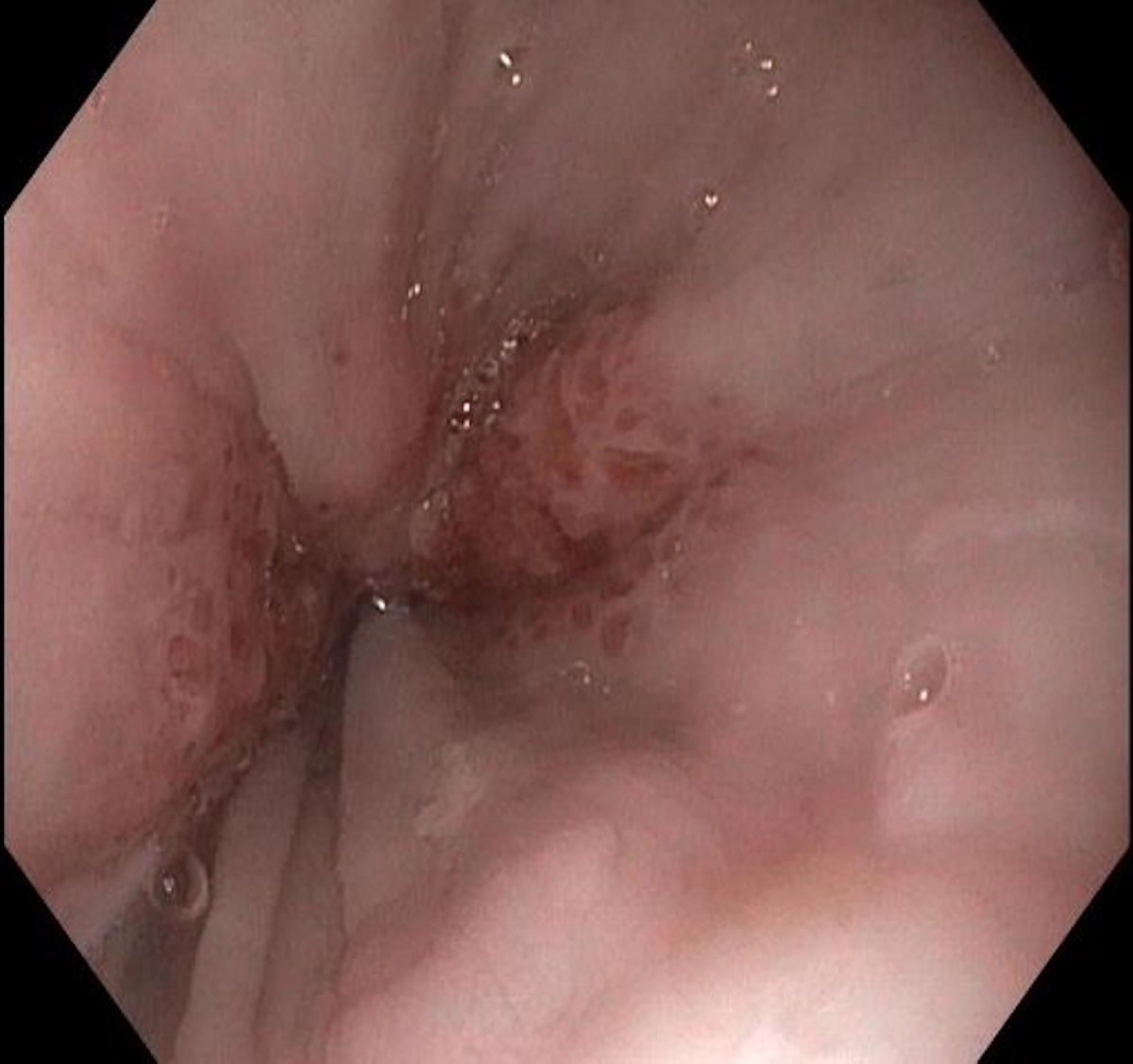Back
Poster Session E - Tuesday Afternoon
E0218 - Pagetoid Spread of Esophageal Adenocarcinoma
Tuesday, October 25, 2022
3:00 PM – 5:00 PM ET
Location: Crown Ballroom
.jpg)
Brian M. Fung, MD
University of Arizona College of Medicine
Phoenix, AZ
Presenting Author(s)
Brian M. Fung, MD, Joseph David, MD
University of Arizona College of Medicine, Phoenix, AZ
Introduction: Pagetoid spread refers to the “upward spreading” of cancer cells into the upper dermis from below. In the esophagus, it is a rare finding seen with poorly differentiated adenocarcinomas and is associated with deeper invasion.
Case Description/Methods: A 75-year-old male with history of diabetes, hypertension, and hyperlipidemia presented to the gastroenterology clinic for dysphagia to solids. He reported that his symptoms started intermittently approximately three weeks prior and had gradually progressed. He denied a history of acid reflux, heartburn, or prior episodes of dysphagia. He also reported an unintentional loss of 10 pounds over the past five months. His medications included lisinopril, metformin, pioglitazone, and simvastatin. He denied a history of tobacco or alcohol use and had no family history of gastrointestinal malignancy. Physical exam was unremarkable. To further evaluate his dysphagia, an esophagogastroduodenoscopy was performed, revealing a small fungating mass in the distal esophagus near the gastroesophageal junction. Superior to this in the distal and mid-esophagus, there was a long segment of circumferential induration with irregular, reticulated erosions (Figure 1). Biopsies of the lesion revealed esophageal adenocarcinoma with pagetoid spread into overlying squamous epithelium, arising in Barrett mucosa with high-grade dysplasia. Endoscopic ultrasound was subsequently performed, revealing a mass measuring 12 mm in thickness with sonographic evidence of invasion into the adventitia and one malignant appearing lymph node in the lower paraoesophageal mediastinum (staged T3, N1).
Discussion: Upper endoscopy is highly sensitive and specific for diagnosing esophageal cancer. However, in cases where there may not be an obvious fungating tumor, the presence of indurated mucosa with reticular erosions should alert the endoscopist to the presence of malignancy, possibly with pagetoid spread and deep invasion, as was seen in this patient.

Disclosures:
Brian M. Fung, MD, Joseph David, MD. E0218 - Pagetoid Spread of Esophageal Adenocarcinoma, ACG 2022 Annual Scientific Meeting Abstracts. Charlotte, NC: American College of Gastroenterology.
University of Arizona College of Medicine, Phoenix, AZ
Introduction: Pagetoid spread refers to the “upward spreading” of cancer cells into the upper dermis from below. In the esophagus, it is a rare finding seen with poorly differentiated adenocarcinomas and is associated with deeper invasion.
Case Description/Methods: A 75-year-old male with history of diabetes, hypertension, and hyperlipidemia presented to the gastroenterology clinic for dysphagia to solids. He reported that his symptoms started intermittently approximately three weeks prior and had gradually progressed. He denied a history of acid reflux, heartburn, or prior episodes of dysphagia. He also reported an unintentional loss of 10 pounds over the past five months. His medications included lisinopril, metformin, pioglitazone, and simvastatin. He denied a history of tobacco or alcohol use and had no family history of gastrointestinal malignancy. Physical exam was unremarkable. To further evaluate his dysphagia, an esophagogastroduodenoscopy was performed, revealing a small fungating mass in the distal esophagus near the gastroesophageal junction. Superior to this in the distal and mid-esophagus, there was a long segment of circumferential induration with irregular, reticulated erosions (Figure 1). Biopsies of the lesion revealed esophageal adenocarcinoma with pagetoid spread into overlying squamous epithelium, arising in Barrett mucosa with high-grade dysplasia. Endoscopic ultrasound was subsequently performed, revealing a mass measuring 12 mm in thickness with sonographic evidence of invasion into the adventitia and one malignant appearing lymph node in the lower paraoesophageal mediastinum (staged T3, N1).
Discussion: Upper endoscopy is highly sensitive and specific for diagnosing esophageal cancer. However, in cases where there may not be an obvious fungating tumor, the presence of indurated mucosa with reticular erosions should alert the endoscopist to the presence of malignancy, possibly with pagetoid spread and deep invasion, as was seen in this patient.

Figure: Circumferential induration with irregular, reticulated erosions found in the mid esophagus during upper endoscopy.
Disclosures:
Brian Fung indicated no relevant financial relationships.
Joseph David indicated no relevant financial relationships.
Brian M. Fung, MD, Joseph David, MD. E0218 - Pagetoid Spread of Esophageal Adenocarcinoma, ACG 2022 Annual Scientific Meeting Abstracts. Charlotte, NC: American College of Gastroenterology.
